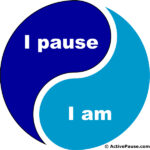
Pausing can be a disruption. It gives us the possibility to be mindful, i.e. to pay attention to our inner experience in relation to what we are doing. This kind of contemplation is not divorced from real life. It is what allows us to find motivation, and a felt sense of meaning and purpose, moment by moment. In other words, to be ourselves. As I pause, I get a sense of who I am & what I want.
For most of us, much of the time, it is difficult to switch gears. The momentum keeps us in default mode. This is the way our mind works. Most of our experiences and processes are unconscious because they don’t require attention. And this makes sense as a way to function efficiently. We only pay attention to the squeaky wheels of experience.
So, in order to pay attention to something that seems not to require attention, we have to turn it into a squeaky wheel. We have to go push against the sense that we already know what it is (i.e., that it requires no attention) and find ways in which it can engage our attention.
We can’t do this by forcing attention. It doesn’t work (or it just works for a brief moment). We can only remain mindfully engaged with something to the extent that it engages our attention, i.e., there is something to process. If there is nothing to process, our mind disengages.
This is why I call this process an active pause. It is a process of actively engaging our attention. We do it by engaging our curiosity, i.e., engaging in a back-and-forth exploration.
This may seem abstract, so I will give you an example. Let’s say you are taking a walk in a State Park. You are not looking for food, and there are no dangers: there are no predators, and the trails are well-marked. So, your attention is not going to be sustained by the need for survival. But you can pay more attention to where you are if you intentionally engage your curiosity. For instance: Are there birds? Are there different kinds of bird songs? Are all the trees the same? Are some trees stunted by others?
In other words: You’re not just giving yourself a general directive of “paying attention.” You engage in specific inquiries. This is an active process.
Now, does it mean that you will find endless fascination with your surroundings during your walk? Not necessarily. It could very well be that you are not really interested in the surroundings. Or that you are more interested in your thoughts. Or that you genuinely enjoy being in the cocoon of your daydreaming. So, the result of your inquiry is to make a conscious choice to stay in your cocoon. Nothing wrong with that. Being mindful of your surroundings has value if it enriches your experience, not if it is a chore that you impose on yourself.
As you read the above, you might conclude that being mindful is a choice that we can all make at will. This is not always the case. When faced with overwhelming circumstances, our nervous system shifts away from mindful engagement and into trauma mode. Mindful engagement requires at least some degree of safety and support. Under trauma, we lose our ability to be fully ourselves. See: Polyvagal-informed mindfulness.